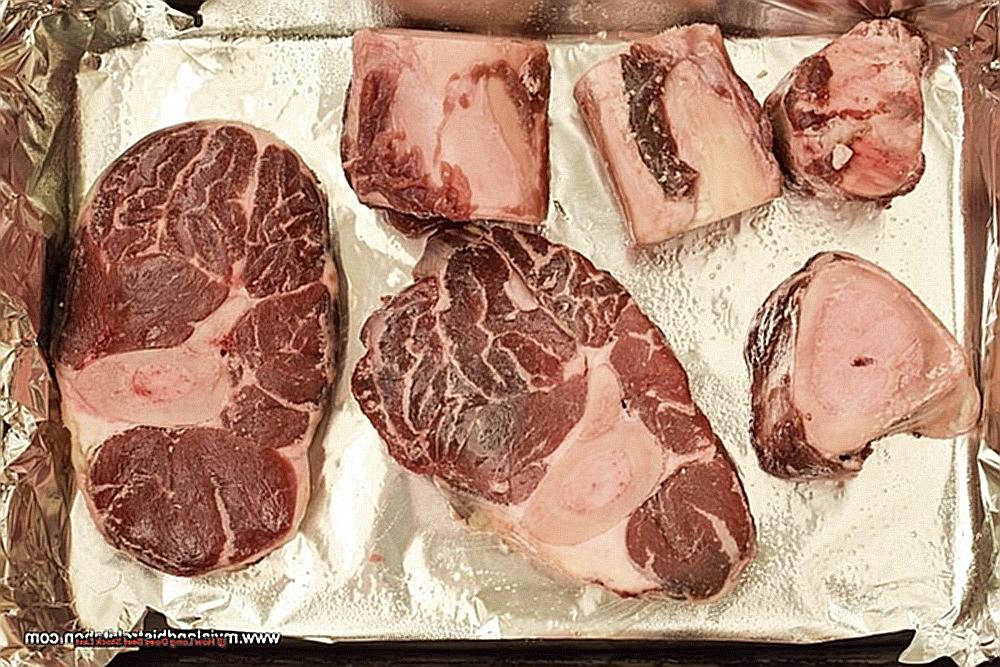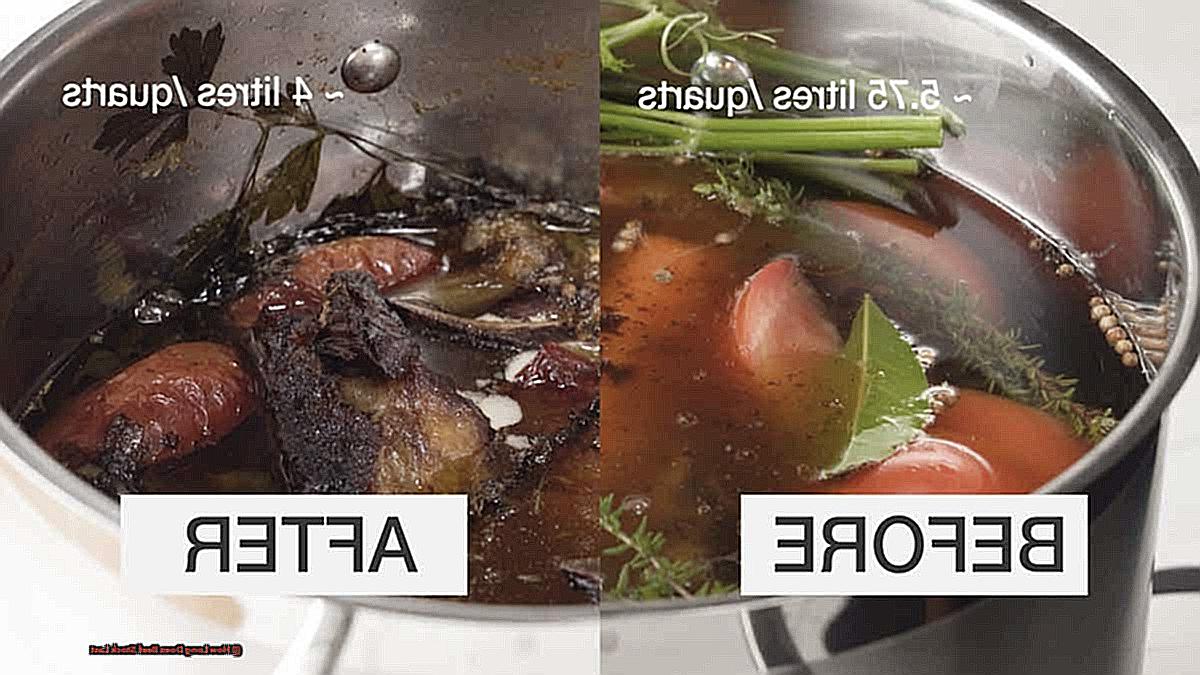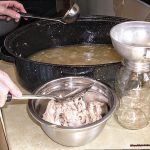Welcome, fellow food enthusiasts, to a discussion on the longevity of beef stock. Ah, the rich and flavorful liquid that elevates our soups, stews, and sauces to new heights. But have you ever paused to ponder how long this savory elixir can last in your pantry? Fear not, my curious comrades, for today we embark on a journey through the world of beef stock. Get ready to uncover its secrets as we explore its shelf life and more. Here are some key points to keep in mind as we delve into this kitchen staple:
- Beef stock is created by simmering bones and aromatics for hours on end, extracting every last drop of deliciousness.
- This versatile ingredient can be used in a multitude of dishes, making it an essential for any home cook.
- However, like any perishable item, beef stock does have a limited shelf life.
- So just how long can you savor its flavors before bidding it adieu?
- And what are some telltale signs that your beloved beef stock has gone bad?
- Fret not, my friends, for all these questions and more will be answered in this blog post.

So grab yourself a warm cup of broth and let’s begin our exploration.
Contents
How to Store Beef Broth?
When it comes to storing beef broth, there are a few methods that stand out as the best options: refrigeration, freezing, and proper labeling. Each method has its own advantages and here’s a breakdown of each one.
Refrigeration:
- If you’ve made homemade beef broth, be sure to transfer it to an airtight container and refrigerate it immediately after it has cooled.
- If you have store-bought beef broth, simply transfer it to an airtight container and store it in the fridge.
- Beef broth can be safely stored in the fridge for up to 4-5 days.
- Keep an eye out for any changes in appearance or smell, mold growth, or a change in taste as these are signs of spoilage.
Freezing:
- For long-term storage, freezing is your best bet when it comes to beef broth.
- It’s best to portion out the broth into smaller containers or freezer bags for easier thawing.
Proper Labeling:
- Don’t forget to label and date your containers of beef broth for better organization and freshness.
- This will also help you keep track of when the broth was made and when it should be consumed by.
- By doing this, you can guarantee that you’re always consuming the freshest and safest beef broth possible.
In addition to these storage methods, it’s important to pay attention to any signs of spoilage. If you notice any damage to the can, changes in appearance or smell, mold growth, or a change in taste, it’s best to dispose of the beef broth. Consuming spoiled beef broth can lead to food poisoning and other health risks.
How Long Does Beef Broth Last?
Beef broth, a popular ingredient in many dishes, has varying shelf lives depending on the type and storage method. If unopened and canned, beef broth can last for 2 to 5 years in the pantry or refrigerator. However, once opened, it should be consumed within 3 to 7 days if stored in the fridge. Keep in mind that these are just rough estimates and the actual shelf life may differ based on the quality of the broth.
To determine if beef broth has spoiled, there are a few indicators to be aware of:
- Change in color: Fresh beef broth should have a deep brown hue, but if you notice a significant change in color, it may have gone bad. A cloudy appearance or green/gray tint is a clear sign to discard it.
- Unpleasant smell: Beef broth should have a savory aroma, but if it smells sour, rotten, or pungent, it is no longer safe to consume.
- Mold growth: The presence of mold on the surface of the broth is a major red flag and should not be consumed as it can lead to food poisoning.
- Packaging issues: Any leaks or bloating in the packaging of your beef broth are warning signs that bacteria may have contaminated the broth. In such cases, it should be discarded immediately.
It is worth noting that these signs may not always be present, especially if the beef broth has been stored correctly. When unsure, it is always better to err on the side of caution and discard any beef broth that you suspect may have gone bad.
Remember to properly store your beef broth and keep an eye out for these signs to ensure the safety of your food.
How to Tell If Beef Broth Has Gone Bad?
It is important to pay attention to any changes in your beef broth before consuming it. If you see any of these signs, it is best to discard the broth. Not only can consuming spoiled or contaminated beef broth lead to food poisoning, but it can also have other health risks.
One noticeable sign of spoilage is mold accumulation. If you see visible mold growth on the surface of the broth, it is best to throw it away. Mold can produce toxins that can cause food poisoning and other illnesses.
Another indicator of spoilage is a pungent or sour odor. If the broth has a foul or acidic smell that is different from its usual scent, it may indicate bacterial growth. Consuming this type of broth can lead to foodborne illness.
You should also be aware of any changes in color or cloudiness in your beef broth. If the broth appears cloudy or has a different color than usual, it could be a sign of spoilage or bacterial growth. It is best to err on the side of caution and discard the broth.
An off flavor is another warning sign that your beef broth has gone bad. If the broth tastes different than before, with a strange or unpleasant taste, it could be an indication of spoilage or bacterial growth. In this case, it is better to be safe than sorry and not consume the broth.
Lastly, if you notice any strange clumps or chunks in your beef broth that were not present before, it could be a sign of bacterial growth. Consuming this type of broth can lead to foodborne illness.
In addition to these signs, it is also important to pay attention to the condition of the container your beef broth is stored in. If the container is dented, leaking, or damaged in any way, it can compromise the safety and quality of the broth.
To ensure the safety and quality of your beef broth, it is important to store it properly and consume it within a reasonable timeframe.
Uses for Beef Broth
Beef broth is a versatile ingredient that adds depth and richness to a variety of dishes. Here are some creative and mouth-watering ways to utilize beef broth in your cooking:
- Utilize it as a base for soups and stews: Beef broth is the ideal base for hearty soups and stews. Its rich flavor adds complexity to the dish, making it more satisfying and flavorful. Try making a classic beef and vegetable soup or a hearty beef stew with beef broth as the base.
- Create a flavorful gravy: Beef broth is also great for creating gravy. Simply mix flour into the broth and whisk until thickened, then season with herbs and spices for a delightful gravy to top your favorite meats.
- Incorporate it in rice dishes: Instead of using plain water to cook rice, try using beef broth for added flavor. It pairs particularly well with brown rice, giving it a savory and nutty taste.
- Enhance sauces and marinades: Add some beef broth to your go-to sauces and marinades for an extra burst of flavor. It works well in BBQ sauces, marinades for steaks, and even pasta sauces.
- Use it in breakfast dishes: Beef broth may not be the first thing that comes to mind when you think of breakfast, but it can add a delicious savory element to dishes like poached eggs or breakfast hash.
- Create a flavorful ramen: Ramen noodles are traditionally cooked in a delectable broth, so why not use beef broth for added richness? You can also add meat, vegetables, and spices to make a hearty meal.
- Utilize it to make gumbo: Gumbo is a traditional Cajun dish that features a flavorful broth made with meat, vegetables, and spices. Beef broth is often used as the base for this dish, adding depth and richness to the flavors.
- Add it to smoothies: This may sound unconventional, but adding a small amount of beef broth to a smoothie can add a savory and protein-packed element to the drink. Try blending it with fruits and vegetables for a nutritious and delicious beverage.
How to Tell If Beef Broth Has Gone Bad?
To determine if your beef broth is no longer safe to consume, check for the following indications:
- A sour or rancid aroma: If the broth has an unpleasant or foul smell, it may be spoiled.
- Discoloration: If the color of the broth has significantly changed, it could be a sign of spoilage.
- Growth of mold: Any mold growth on the broth’s surface should be discarded immediately.
- Cloudiness: If the broth looks cloudy or murky, there may be bacterial growth.
- Presence of sediment: Strange clumps or particles in the broth are not a good sign and should be discarded.
- Change in color: If the clear broth has turned into a darker hue, it may have gone bad.
- Unusual lumps: Any unusual lumps or clumps in the broth could indicate spoilage.
When determining if beef broth has gone bad, consider factors such as storage methods and expiration dates. Properly stored unopened store-bought beef broth can last 1-2 years past the “best by” date. Once opened, leftover beef broth should be consumed within 4-5 days if stored in an airtight container in the fridge. Homemade beef broth should also be consumed within 3-4 days and refrigerated throughout.
Aside from these signs and storage guidelines, pay attention to changes in taste when consuming beef broth. If it tastes off or has an odd flavor, it is best to discard it.
It is always better to err on the side of caution when it comes to food safety. If you are uncertain about the safety or quality of your beef broth, throw it out. Eating spoiled food can lead to food poisoning and other health risks.
Uses for Beef Broth
Leftover beef broth is a versatile and flavorful ingredient that can be used in a variety of dishes, adding depth and richness while also reducing food waste. Here are some creative and delicious ways to utilize leftover beef broth:
- Enjoy it as a hot drink: Heat up the beef broth and savor it as a savory alternative to tea or coffee. For an extra kick of flavor, try adding spices such as ginger, garlic, or black pepper.
- Elevate rice or pasta dishes: Instead of using water, substitute beef broth when cooking rice or pasta to infuse them with rich and delicious flavors.
- Upgrade your ramen: Switch out the traditional water in your instant ramen with beef broth for a more satisfying and flavorful meal.
- Make a unique latte: Surprisingly, beef broth can be used as a substitute for milk in lattes. Simply heat up the broth and froth it before adding it to your coffee.
- Create a mouth-watering gravy: Use the beef broth to make a delectable gravy for mashed potatoes, roasted meats, or other dishes that pair well with this savory sauce.
Flavor your potatoes: Boil potatoes in beef broth instead of water for an extra burst of flavor.
- Whip up a hearty gumbo: Utilize leftover beef broth as the base for a delicious gumbo, along with vegetables, meats, and spices.
- Use it in soups: Beef broth is an essential ingredient in many soups, such as French onion soup, chili, or beef stew.
- Incorporate it into smoothies: For a protein-packed smoothie with added flavor, use leftover beef broth instead of water or milk.

| Food Item | Fridge Storage Period |
| Beef Broth (fresh) | 3 to 4 days |
| Beef Broth (cooked) | 3 to 4 days |
Keep in mind that these storage periods are just guidelines and may vary depending on how the broth is prepared and stored. Always use your best judgement and follow proper food safety practices.
By incorporating and getting creative with leftover beef broth in these unique and delicious ways, not only are you enhancing the flavors of your dishes, but you are also reducing food waste.
Conclusion
Beef stock, a versatile and essential ingredient in any kitchen, adds depth and richness to a variety of dishes.
However, like any perishable item, it has a limited shelf life that must be taken into consideration. Properly storing beef broth in the fridge or freezer and being aware of signs of spoilage are crucial for ensuring its safety and quality.
Don’t let your precious homemade beef stock or canned broth go to waste – get creative with leftover broth to enhance the flavors of other dishes while also reducing food waste.




